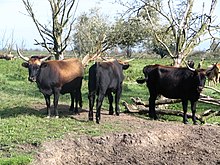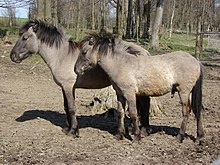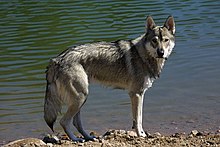Image breeding
An image breeding , also called back breeding , is understood to mean an animal breed that is bred with the aim of phenotypically approximating the wild form of the respective domestic animal (examples: aurochs, wild horses) or an extinct domestic animal breed (example, Düppeler willow pig ) . These are mostly intersectionsmade by breeds of domestic animals with original physical and / or essential characteristics. Breeding images cannot replace or restore the extinct wild form or breed, but only imitate it. As a result, the commonly used synonym "backbreeding" is imprecise and misleading. There are also partial image cultivations such as B. the Tamaskan , in which a breed is only matched in its external appearance to a still existing wild form and crossbreeding of the wild form is dispensed with in order to keep the image breeding free of undesirable behavioral characteristics of the wild form.
The authenticity of a reproduction of an image depends on the quality of the implementation. Some breeds, such as the Heck cattle , only give a vague or even wrong picture of the trunk shape. Image breeding is not to be confused with dedomestication and backcrossing .
focus
While in nature those individuals survive and reproduce that are well adapted to the environmental conditions of their habitat , in the course of domestication, humans often select particularly sociable, conspicuous or productive animals for breeding. Thus, the different selection conditions of nature and of man, which is why animals through domestication in appearance , behavior and genetics change. The aim of image breeding is to breed a breed that is close to or resembles the extinct ancestral form of a pet. Usually only phenotypic characteristics are considered, but individual projects, such as TaurOs Project , also consider the genetic aspect. For image breeding, individual original characteristics that are still found in different breeds of this domestic animal have to be reassembled in the way that they are assumed to be in the extinct parent species. The prerequisite for this is that these sought-after individual properties are still present in various domesticated breeds or individual animals. Animals with such characteristics are then selected and purposefully crossed.
Since it is possible that not all alleles of the parent forms are present in the modern offspring, or the breeder is not aware of all phenotypic aspects of the wild animal, it is always questionable whether an animal created in this way can actually fully correspond to its parent form. In order to adequately cover genetic aspects, both the mitochondrial and the nuclear genome of the extinct wild forms would have to be deciphered.
Since many primitive domestic animal breeds have inherited behavioral aspects from their extinct ancestors and are able to survive in natural conditions, it is believed that substitute breeds in the wild act similarly to their ancestors . Because through domestication, humans have mainly changed external physical characteristics, but not internal mechanisms such as the digestive system. The food spectrum should therefore be the same for the wild form and the dedomesticated house form. Also, natural selection in the wild after reintroduction of animals caused by breeding back the breed over many generations introduce even closer to the wild type, since there the individuals with the most important for the survival properties propagate the most successful. In the case of large herbivores, this would require a sufficient supply of appropriate predators, which is often not available in Europe today. After all, although image breeding has led to an animal similar to the original, its gene pool has been lost with its extinction and cannot be restored.
A distinction must be made between image breeding from domestic animals and their ancestral form and image breeding from non-domesticated animals related to an exterminated animal, since the former method uses the modified offspring of the desired animal, while the latter method uses a completely different species or subspecies. Here, too, the animals that are still alive and most similar to the target animal are selected and crossed in order to obtain an animal that looks more like the extinct animal shape through targeted selection , such as the quagga . Since the quagga was a separate population of the plains zebra , Equus quagga , the special alleles of this form have disappeared when they became extinct. Any similarities between today's plains zebras will therefore be of a purely superficial nature.
purpose
Authentic reproductions are particularly interesting for renaturation and nature conservation , as they can act as a substitute for the stem forms that humans have exterminated. It can be assumed that successful breeding of images fulfills the ecological criteria of the wild form if, for example, aspects such as choice of food, robustness, defense against predators or hunting instincts, etc. largely correspond to those of the wild form. The release of the animals, which act in a similar way to the ancestral form, is therefore the reintroduction of an ecological component that was once lost through the influence of humans, such as habitat destruction or hunting. It enables an interplay of animal and plant species in an ecosystem that is true to the original . Incidentally, an image breeding does not automatically have to be the breed that is most similar to the parent form, as this depends on the quality of the implementation of the breeding attempt and the originality of other breeds. An example of this is the Heck cattle, which shares fewer phenotypic characteristics with the Ur than the Spanish battle cattle.
Breeding with domesticated offspring
Aurochs
The aurochs died out in 1627 as a result of centuries of habitat fragmentation and hunting. In modern nature conservation, the role of large herbivores in ecosystems is recognized as essential ( see mega herbivore hypothesis ), which is why there is a need for a suitable substitute for this wild animal. Although the idea of such an experiment was formulated as early as 1835 ( see main article ), it was first implemented on a trial basis by the brothers Heinz and Lutz Heck . According to scientific literature, the resulting tail cattle is essentially a robust cattle with the usual body structure of a domestic cattle as well as color characteristics of the aurochs and longer horns.
Since the Heck cattle deviates phenotypically from the original in many respects, various authors want better breeding of images. For example, the Working Group on Biological Environmental Protection and NABU, who want to cross old cattle breeds such as Sayaguesa , Spanish Combat Cattle and Chianina with Heck cattle and, through selective breeding, want to create a cattle that looks more like the aurochs, the Taurus cattle . Another project, TaurOs Project , completely dispenses with Heck cattle and works with primitive breeds according to narrower criteria; Sayaguesa, Pajuna , Maremmana primitivo , Limia cattle , Maronesa and - in more northern Tauros herds - the Scottish highland cattle are used here.
Tarpan
Contrary to popular belief, the Polish Konik horse is not the result of a backbreeding project, but a Polish country horse breed. The Heck brothers crossed these Koniks with other horse breeds, such as Gotland ponies , Icelandic horses and Przewalski horses . These rear horses , often referred to as "Tarpan image breeding", were later crossed again and again with the Koniks and are often not visually distinguishable from these today, but they are more finely built.
In addition to the Konik / Heck horse, the Exmoor pony is also attested to be close to European wild horses. This also has an original, small stature and a robust skull structure and shows a clear similarity in color to cave paintings, for example from Lascaux and Przewalski's horses . For example, there is a white mouth, white circles under the eyes and a light underside of the body. Nevertheless, the Exmoor pony is simply an original horse breed.
wolf
The wolf , the ancestral form of the domestic dog , is by no means extinct, but its phenotypic appearance is the breeding goal of some dog breeds. An example of this is the Tamaskan , which emerged from the crossbreeding of German shepherd dogs and sled dogs , which were selected according to wolf characteristics. The Tamaskan is therefore also an image breed.
Breeding with similar species or subspecies
Quagga
The quagga is a subform of the plains zebra that was exterminated at the end of the 19th century and was characterized by a reduction in stripes, especially on the back of the body. The Quagga Project tries to obtain an optical imitation of this animal through selective breeding to reduce stripes. Some specimens already show this clearly, but the similarities with the quagga will remain purely superficial in nature.
Canis dirus
The Dire Wolf Project is trying to create a dog breed that is supposed to resemble the wild dog Canis dirus , which disappeared from the fossil record around 10,000 years ago, in terms of skeletal structure, the only known aspect of the phenotype of this species. The resulting dog breed is called "American Alsatian".
Individual evidence
- ↑ a b c Cis van Vuure: Retracing the Aurochs - History, Morphology and Ecology of an extinct wild Ox. 2005. ISBN 954-642-235-5
- ↑ https://content.time.com/time/health/article/0,8599,1961918,00.html Auroch's Project Aims to Breed Extinct Ancient Cattle
- ↑ Bunzel-Drüke, Finck, Kämmer, Luick, Reisinger, Riecken, Riedl, Scharf & Zimball: "Wilde Weiden: Practical guidelines for year-round grazing in nature conservation and landscape development
- ↑ http://www.taurosproject.com/ TaurOs Project
- ^ Tadeusz Jezierski, Zbigniew Jaworski: The Polish Konik. Die Neue Brehm-Bücherei Vol. 658 , Westarp Sciences, Hohenwarsleben 2008, ISBN 3-89432-913-0
- ↑ http://www.eurowildlife.org/news/wild-horses-for-europe–-which-breed-is-the-best/ European Wildlife about wild horse replacement in Europe
- ↑ C. Gamborg et al .: de-domestication: Ethics at the Intersection of Landscape Restoration and Animal Welfare In: Environmental Values in 2010, 19 (1): 57-78
- ↑ http://www.quaggaproject.org/ Quagga Project
- ↑ http://www.direwolfproject.com/ Dire Wolf Project



